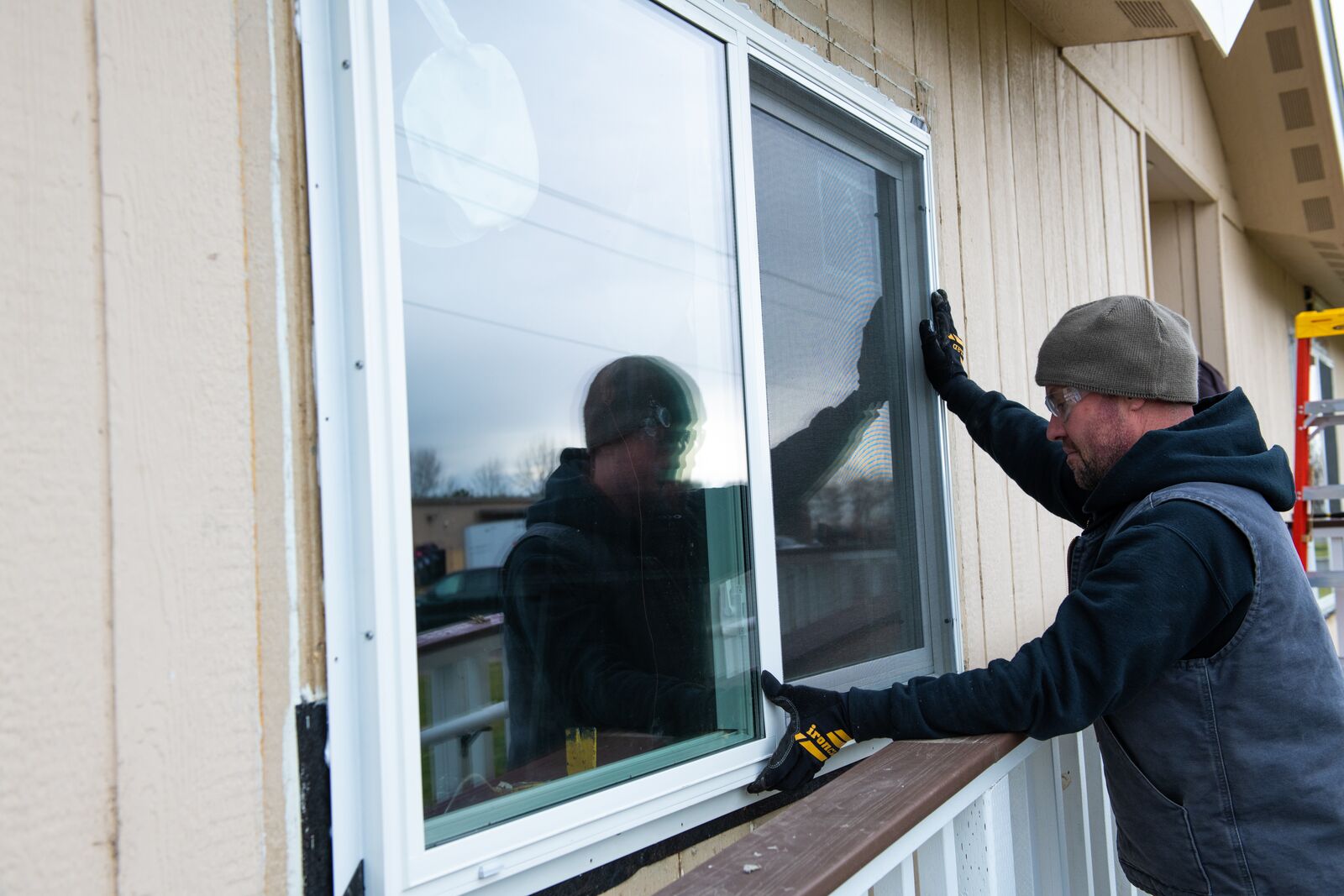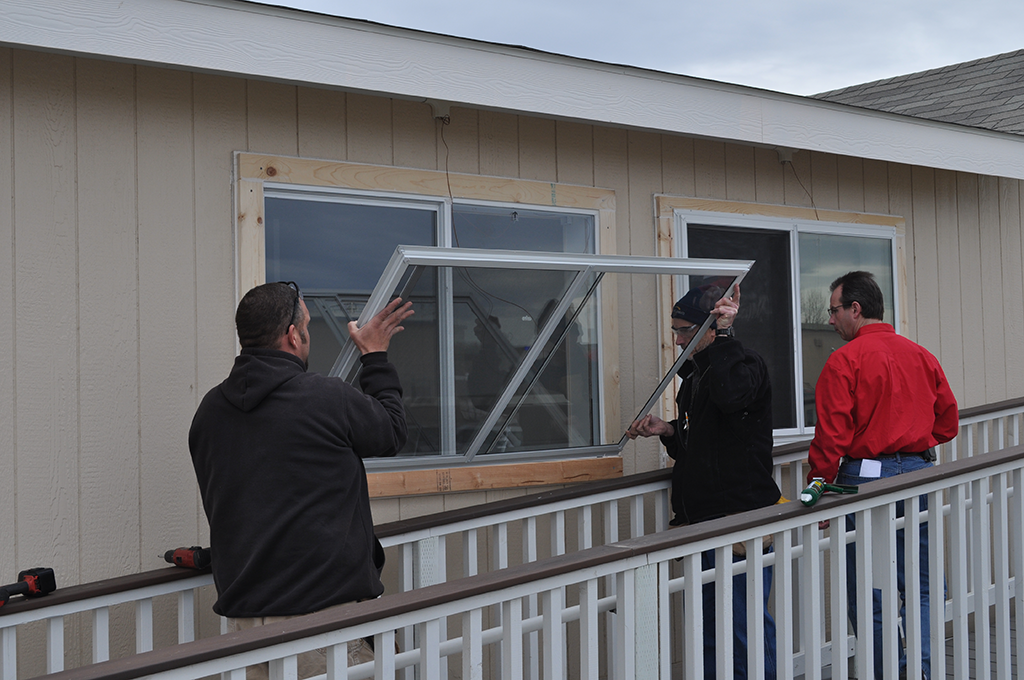PNNL Lab Homes Experiments
The following is a list of experiments that have been completed at the Pacific Northwest National Laboratory (PNNL) Lab Homes, located on the PNNL-Richland campus in Washington.
Highly Insulating Windows | Low-E Storm Windows and Cellular Shades | High-Performance Equipment |
Highly Insulating Windows

While wall insulating techniques and products have dramatically improved in the past 100 years, windows continue to be a weak spot in the thermal envelope across all building types. Improving the insulation and solar heat gain characteristics of a home’s windows has the potential to significantly improve the home’s overall thermal performance by reducing heat loss (in the winter) and heat gain (in the summer). High-quality installation of these windows can also reduce air leakage through the building envelope, thereby increasing the effectiveness of the new technologies that do exist today in any application. Recent studies in the PNNL Lab Homes have helped quantify the energy savings of new window technologies and the installation of those technologies, for manufacturers and utilities alike.
PNNL has conducted two full experiments on highly insulating windows, including a typical triple-pane window experiment and a thin-triple-pane window experiment. The new generation of thin-triple-pane windows are less expensive and can be more easily retrofitted into existing double-pane frames compared with older triple-pane windows. These next-generation windows take advantage of economies of scale through their use of typical double-pane window frames and thin glass that is otherwise used in flatscreen TVs.
Over the course of two 10-week periods in the PNNL Lab Homes, the windows enabled the homes to achieve average energy savings of 12 percent on heating and 28 percent on cooling when compared with a home that had double-pane windows with metal frames. In addition, in the home with the thin-triple-pane windows, outdoor noise was reduced and indoor temperatures were much more consistent throughout the home during both the summer and winter testing periods.
PNNL has worked with manufacturers to help optimize the cost and performance over several laboratory and field validation sites, resulting in proof that the thin-triple-pane technology meets certain cost-effective criteria outlined by regional technical resource manuals (TRMs). For example, Michigan cited PNNL’s findings on triple-pane windows in the state’s TRM, making triple-pane windows eligible for utility incentives.
Following this work and proof of concept, four U.S. manufacturers (Alpen, Kensington, Ply Gem, and Renewal by Andersen) are now selling thin-triple-pane windows. Additionally, Alpen and PGT-Corning are expanding production of their insulated glass units for business-to-business sales to all window manufacturers with double-pane frames nationwide. Through PNNL’s extensive laboratory testing and field validation expertise, the industry is provided with crucial data to develop products that are affordable, efficient, and user-friendly.
Resources
Gunderson P.K., E. Louie, and K.A. Cort. 2024. "Laboratory and Field Validation of the Performance Benefits and Costs of Thin Triple-Pane Windows in Residential Buildings." Science and Technology for the Built Environment 30, no. 7:767-784. PNNL-SA-191549. DOI:10.1080/23744731.2024.2357529.
Gunderson P.K., E. Louie, C.E. Metzger, S.I. Rosenberg, and K.A. Cort. 2022. "Results from Laboratory and Field Study of Thin Triple Pane Windows." In Proceedings of the 15th International Conference on Thermal Performance of the Exterior Envelopes of Whole Buildings (Buildings XV), December 5-8, 2022, Clearwater Beach, FL, 667 - 675. Peachtree Corners, Georgia: American Society of Heating Refrigerating and Air-Conditioning Engineers (ASHRAE). PNNL-SA-172226.
Parker G.B., S.H. Widder, and N.N. Bauman. 2012. Field Evaluation of Highly Insulating Windows in the Lab Homes: Winter Experiment. PNNL-21524, Pacific Northwest National Laboratory, Richland, WA. Abstract | Full Publication
Widder S.H., G.B. Parker, M.C. Baechler, and N.N. Bauman. 2012. Side-by-Side Field Evaluation of Highly Insulating Windows in the PNNL Lab Homes. PNNL-21678, Pacific Northwest National Laboratory, Richland, WA. Abstract | Full Publication
Low-E Storm Windows and Cellular Shades

A storm window is a secondary window or panel that attaches to the inside or outside of the primary (or existing) window. Modern storm windows stay installed year-round to insulate and air-seal existing windows, improving energy efficiency without the need for full window replacement. Low-E storm windows have a nearly invisible low-emissivity coating on the glass that reduces heat loss in the winter and can also help reduce heat gain in the summer. Both interior and exterior low-E storm windows were tested in the PNNL Lab Homes.
Cellular shades are designed to trap air inside pockets that act as insulators, and they can increase the thermal resistance of the window covering and reduce the thermal heat transfer through the window. The specific technology examined in the PNNL Lab Homes was a honeycomb fabric shade, made with six layers of fabric (including two opaque layers) and five insulating air pockets. The insulating air pockets—and a layer of metallized Mylar lining those pockets—minimize conductive, convective, and radiant heat transfer. These experiments involved measurement of the energy savings from window attachment products at different operational schedules in an experimental home relative to the amount of energy used by a control home equipped with standard double-pane, clear-glass windows.
Results from PNNL Lab Home studies, as well as results from modeling studies and field monitoring data, have shown exciting promise for the energy savings and cost effectiveness of low-E storm windows and cellular shades. Additionally, the PNNL Lab Homes findings and information from the Attachments Energy Rating Council show that window attachments can improve the performance of existing windows enough to reduce a household’s annual energy use by up to 13 percent, without requiring the homeowner to adjust their daily routine.
Resources
Cort K.A., J.A. McIntosh, C.E. Metzger, T.D. Ashley, and G.P. Sullivan. 2018. "Completing the Connected Home with Smart Window Shades." In ACEEE Summer Study on Energy Efficiency in Buildings, August 12-17, 2018, Pacific Grove, CA, 12-1 - 12-12. Washington, District Of Columbia: American Council for an Energy-Efficient Economy. PNNL-SA-135343.
Cort K.A., J.A. McIntosh, G. Sullivan, T.D. Ashley, C.E. Metzger, and N. Fernandez. 2018. Testing the Performance and Dynamic Control of Energy-Efficient Cellular Shades in the PNNL Lab Homes. PNNL-27663 Rev 1. Richland, WA: Pacific Northwest National Laboratory. DOI:10.2172/1477792. Testing the Performance and Dynamic Control of Energy-Efficient Cellular Shades in the PNNL Lab Homes
Modeling Cellular Shades in EnergyPlus: https://aercenergyrating.org/wp-content/uploads/2023/01/PNNL_Cellular-Shade-Modeling-EnergyPlus_Dec-17.pdf
Evaluation of Cellular Shades in the Lab Homes: https://labhomes.pnnl.gov/documents/PNNL_24857_Cellular_Shades_rev2.pdf
Gilbride T.L., and K.A. Cort. 2016. "Low-E Storm Windows Gain Acceptance as a Home Weatherization Measure." Home Energy 33, no. 3:12-17. PNNL-SA-115342.
Petersen J.M., K.A. Cort, S.H. Widder, T.D. Culp, and G. Sullivan. 2016. "Mind the Gap: Summary of Window Residential Retrofit Solutions." In ACEEE Summer Study on Energy Efficiency in Buildings, August 21-26, 2016, Pacific Grove, CA, 1-1- 1-12. Washington DC: American Council for an Energy-Efficient Economy. PNNL-SA-117151.
Culp T.D., S.H. Widder, and K.A. Cort. 2015. Thermal and Optical Properties of Low-E Storm Windows and Panels PNNL-24444, Pacific Northwest National Laboratory, Richland, WA. Abstract | Full Publication
Culp T.D., S.H. Widder, and K.A. Cort. 2015. Interior and Exterior Low-E Storm Window Installation Video PNNL-24444, Pacific Northwest National Laboratory, Richland, WA. Abstract | Video
Knox, J.R., and S.H. Widder. 2014. Evaluation of Low-E Storm Windows in the PNNL Lab Homes. PNNL-23355, Pacific Northwest National Laboratory, Richland, WA.
Abstract | Full Publication
Cort K.A. 2013. "DOE's Building America Low-E Storm Window Adoption Program." Presented by Cort, Katherine (Invited Speaker) at the 10th Annual CEE Industry Partners Meeting: Residential Windows Working Group Workshop, Atlanta, Georgia, GA on September 17, 2013. PNNL-SA-98315. Abstract | Full Publication
High-Performance Equipment

Space conditioning and water heating account for 56 percent of total residential energy use in this country (U.S. Energy Information Administration, Table 4: Residential Sector Key Indicators and Consumption). Therefore, high-performance water heating and heating, ventilation, and air conditioning (HVAC) systems are important aspects of residential energy-savings research.
PNNL has studied a number of high-performance HVAC and water heating systems—including combination HVAC and water heating systems—as well as the interactions between multiple heating sources in a home with central and zonal equipment, for example. Additionally, PNNL has conducted experiments in the Lab Homes to improve understanding of the load-shifting characteristics of high-performance HVAC and water heating equipment.
Recently, PNNL completed a project to add gas lines to the PNNL Lab Homes, enabling the study of a greater variety of efficient HVAC and water heating technologies.
Resources
Munk J., W. Hunt, T. Gehl, J. Rendall, and C.E. Metzger. 2023. Field Performance of R-1234yf Heat Pump Water Heaters. PNNL-34257. Richland, WA: Pacific Northwest National Laboratory. Field Performance of R-1234yf Heat Pump Water Heaters
Ashley T.D., C.E. Metzger, J.T. Kolln, and G.P. Sullivan. December 2019. Maximizing the Use of Ductless Mini-Splits in the PNNL Lab Homes. PNNL-29531.
Maximizing The Use Of Ductless Mini-split Systems In Residential Buildings With Existing HVAC Equipment In EnergyPlus. Zhihong Pang, Yan Chen, Cheryn Metzger, Christopher Dymond, Zheng O'Neill, Jian Zhang: https://publications.ibpsa.org/conference/paper/?id=bs2019_211079
Metzger C.E., J.A. McIntosh, K. Eklund, and J.M. Petersen. March 2018. CO2 Combi System Compared to Other Systems in the PNNL Lab Homes. Presented by Cheryn E Metzger at ACEEE Hot Water Forum, Portland, Or, United States. PNNL-SA-133462.
Metzger C.E., J. Zhang, J. Winkler, and J. Maguire. 2018. "Are Ducted Mini-Splits Worth It?." ASHRAE Journal 60, no. 2:22-31. PNNL-26834.
Metzger C.E., J.M. Petersen, and J.A. McIntosh, 2017. PNNL Lab Home Results for the CO2 Combination Space Conditioning and Water Heating Stress Tests. PNNL-26462, Pacific Northwest National Laboratory, Richland, WA.
Metzger C.E., J.M. Petersen, J.A. McIntosh, and Ken Eklund, 2017. PNNL Lab Homes Results for CO2 Combi System Stress Tests. PNNL-SA-124240, Presented on February 27, 2017 at the 2017 ACEEE Hot Water Forum, Portland, OR.
Metzger C.E., S.H. Widder, J.M. Petersen, and J.A. McIntosh, 2017. Space Conditioning Interactions with Heat Pump Water Heaters: A Test in the PNNL Lab Homes. PNNL-SA-124136, Presented on February 27, 2017 at the 2017 ACEEE Hot Water Forum, Portland, OR.
Sullivan G.P. and J.P. Petersen. July 2015. Demand-Response Performance of Sanden Unitary and Split-System Heat Pump Water Heaters. PNNL - 24224, Pacific Northwest National Laboratory, Richland, WA.
Sullivan G.P., J.P. Petersen, S.W. Widder, and G.B. Parker. March 2015. Demand Response Performance of GE Electric Resistance and Sanden Unitary and Split-System Heat Pump Water Heaters. PNNL - 24225, Pacific Northwest National Laboratory, Richland, WA.
Mayhorn E.T., S.H. Widder, S.A. Parker, R.M. Pratt, and F.S. Chassin. 2015. Evaluation of the Demand Response Performance of Electric Water Heaters. PNNL-23527, Pacific Northwest National Laboratory, Richland, WA.
Widder S.H., J.M. Petersen, G.B. Parker, and M.C. Baechler. 2014. Impact of Ducting on Heat Pump Water Heater Space Conditioning Energy Use and Comfort. PNNL-23526, Pacific Northwest National Laboratory, Richland, WA. Abstract | Full Publication
Widder S.H., J.M. Petersen, G.B. Parker, and M.C. Baechler. 2013. Demand Response Performance of GE Hybrid Heat Pump Water Heater. PNNL-22642, Pacific Northwest National Laboratory, Richland, WA. Abstract | Full Publication
Widder S.H. 2013. "Evaluation of Ducted GE Hybrid Heat Pump Water Heater in the PNNL Lab Homes." Presented by Sarah Widder at DOE Building America Program Review, Richland, WA on April 24, 2013. PNNL-SA-95180. Abstract | Full Publication